Marketing Communication Plan and Strategies for Aria Sydney Restaurant
VerifiedAdded on 2021/01/01
|10
|2703
|279
Report
AI Summary
This report presents a comprehensive marketing communication plan developed for Aria Sydney Restaurant, a renowned establishment in Australia. The plan begins with an executive summary and situational analysis, assessing the company, its competitors, consumers, and the market landscape. It identifies the target consumer as millennials and outlines specific marketing and communication objectives, including enhancing sales and website views. The report details the restaurant's positioning and branding strategy, emphasizing loyalty programs and social media marketing. It then delves into creative strategies, focusing on AI-driven customer communication. Marketing communication strategies are explored, including advertising, sales promotion, public relations, direct marketing, and digital strategies. Finally, the report outlines an action/media plan, including media selection, reach, frequency, human resources, timing, and budget considerations, providing a holistic view of the restaurant's marketing approach.
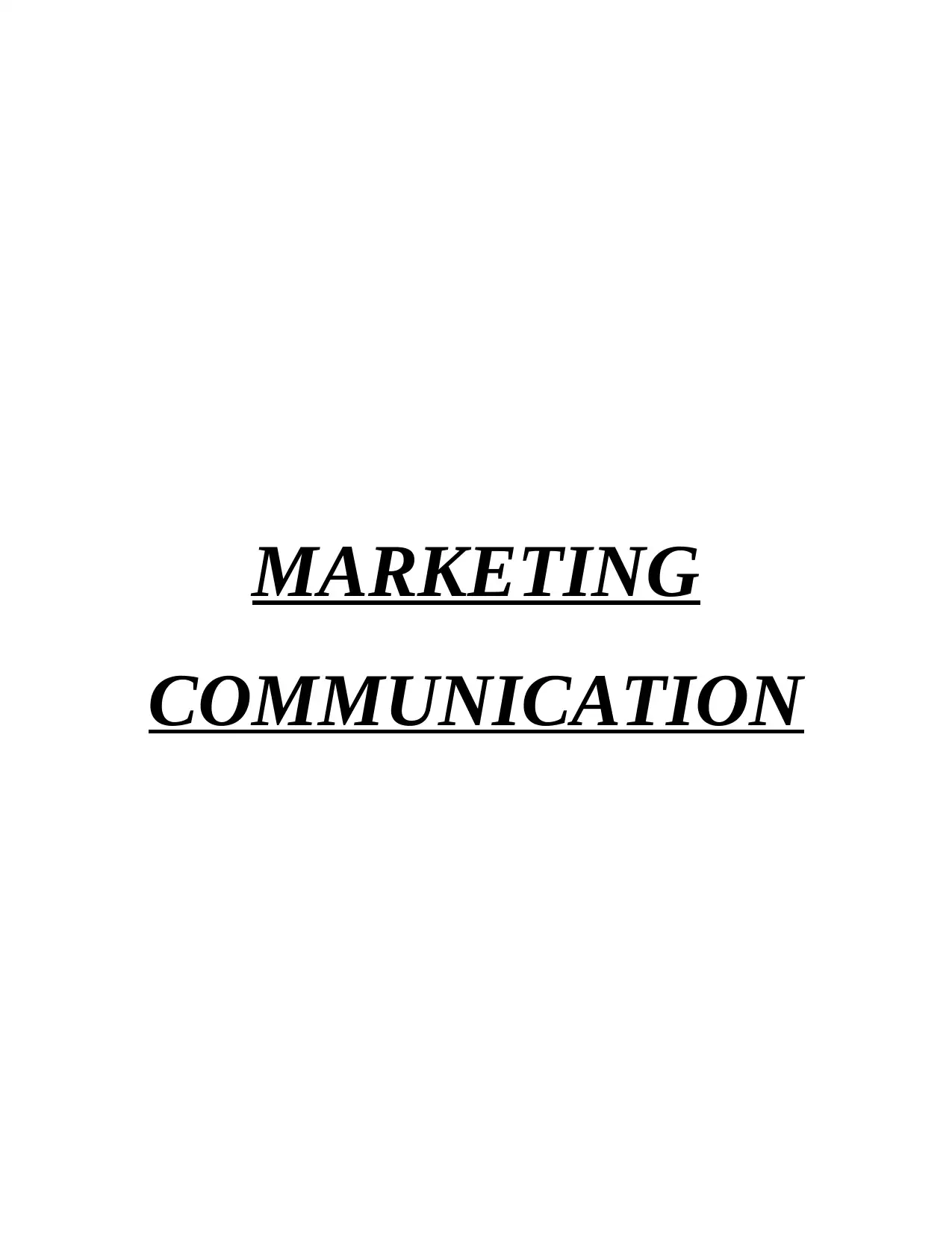
MARKETING
COMMUNICATION
COMMUNICATION
Paraphrase This Document
Need a fresh take? Get an instant paraphrase of this document with our AI Paraphraser
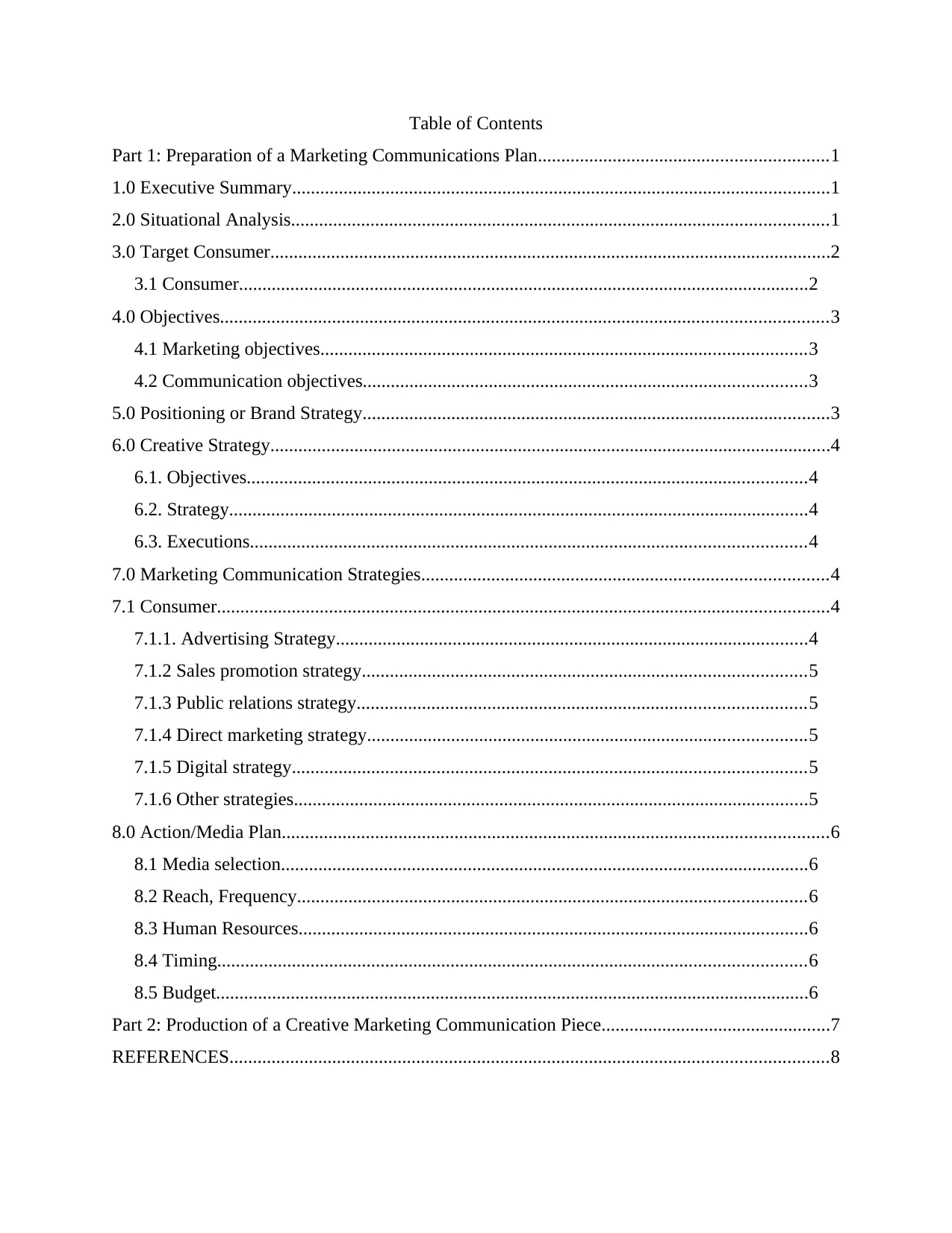
Table of Contents
Part 1: Preparation of a Marketing Communications Plan..............................................................1
1.0 Executive Summary...................................................................................................................1
2.0 Situational Analysis...................................................................................................................1
3.0 Target Consumer........................................................................................................................2
3.1 Consumer..........................................................................................................................2
4.0 Objectives..................................................................................................................................3
4.1 Marketing objectives........................................................................................................3
4.2 Communication objectives...............................................................................................3
5.0 Positioning or Brand Strategy....................................................................................................3
6.0 Creative Strategy........................................................................................................................4
6.1. Objectives........................................................................................................................4
6.2. Strategy............................................................................................................................4
6.3. Executions.......................................................................................................................4
7.0 Marketing Communication Strategies.......................................................................................4
7.1 Consumer...................................................................................................................................4
7.1.1. Advertising Strategy.....................................................................................................4
7.1.2 Sales promotion strategy...............................................................................................5
7.1.3 Public relations strategy................................................................................................5
7.1.4 Direct marketing strategy..............................................................................................5
7.1.5 Digital strategy..............................................................................................................5
7.1.6 Other strategies..............................................................................................................5
8.0 Action/Media Plan.....................................................................................................................6
8.1 Media selection.................................................................................................................6
8.2 Reach, Frequency.............................................................................................................6
8.3 Human Resources.............................................................................................................6
8.4 Timing..............................................................................................................................6
8.5 Budget...............................................................................................................................6
Part 2: Production of a Creative Marketing Communication Piece.................................................7
REFERENCES................................................................................................................................8
Part 1: Preparation of a Marketing Communications Plan..............................................................1
1.0 Executive Summary...................................................................................................................1
2.0 Situational Analysis...................................................................................................................1
3.0 Target Consumer........................................................................................................................2
3.1 Consumer..........................................................................................................................2
4.0 Objectives..................................................................................................................................3
4.1 Marketing objectives........................................................................................................3
4.2 Communication objectives...............................................................................................3
5.0 Positioning or Brand Strategy....................................................................................................3
6.0 Creative Strategy........................................................................................................................4
6.1. Objectives........................................................................................................................4
6.2. Strategy............................................................................................................................4
6.3. Executions.......................................................................................................................4
7.0 Marketing Communication Strategies.......................................................................................4
7.1 Consumer...................................................................................................................................4
7.1.1. Advertising Strategy.....................................................................................................4
7.1.2 Sales promotion strategy...............................................................................................5
7.1.3 Public relations strategy................................................................................................5
7.1.4 Direct marketing strategy..............................................................................................5
7.1.5 Digital strategy..............................................................................................................5
7.1.6 Other strategies..............................................................................................................5
8.0 Action/Media Plan.....................................................................................................................6
8.1 Media selection.................................................................................................................6
8.2 Reach, Frequency.............................................................................................................6
8.3 Human Resources.............................................................................................................6
8.4 Timing..............................................................................................................................6
8.5 Budget...............................................................................................................................6
Part 2: Production of a Creative Marketing Communication Piece.................................................7
REFERENCES................................................................................................................................8
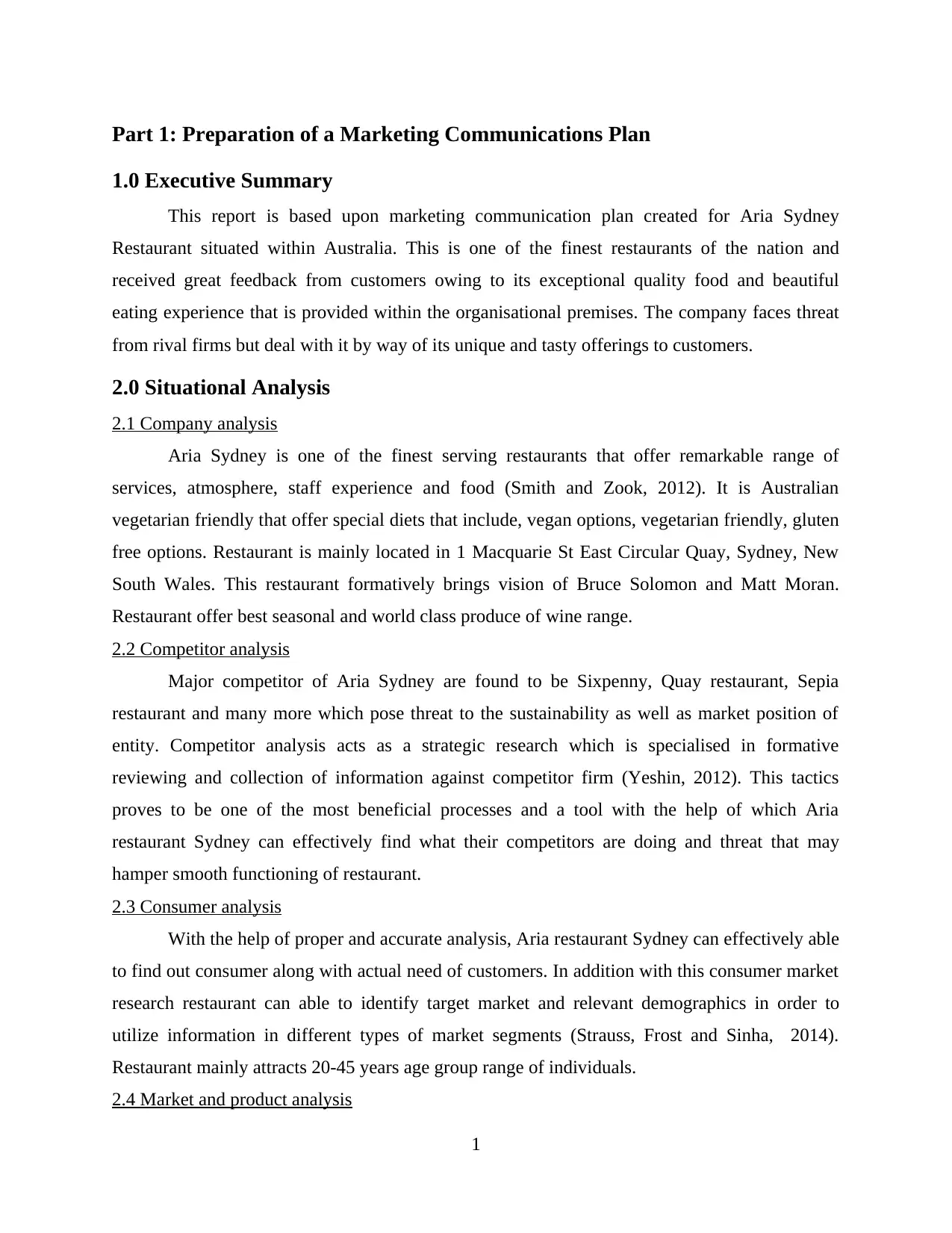
Part 1: Preparation of a Marketing Communications Plan
1.0 Executive Summary
This report is based upon marketing communication plan created for Aria Sydney
Restaurant situated within Australia. This is one of the finest restaurants of the nation and
received great feedback from customers owing to its exceptional quality food and beautiful
eating experience that is provided within the organisational premises. The company faces threat
from rival firms but deal with it by way of its unique and tasty offerings to customers.
2.0 Situational Analysis
2.1 Company analysis
Aria Sydney is one of the finest serving restaurants that offer remarkable range of
services, atmosphere, staff experience and food (Smith and Zook, 2012). It is Australian
vegetarian friendly that offer special diets that include, vegan options, vegetarian friendly, gluten
free options. Restaurant is mainly located in 1 Macquarie St East Circular Quay, Sydney, New
South Wales. This restaurant formatively brings vision of Bruce Solomon and Matt Moran.
Restaurant offer best seasonal and world class produce of wine range.
2.2 Competitor analysis
Major competitor of Aria Sydney are found to be Sixpenny, Quay restaurant, Sepia
restaurant and many more which pose threat to the sustainability as well as market position of
entity. Competitor analysis acts as a strategic research which is specialised in formative
reviewing and collection of information against competitor firm (Yeshin, 2012). This tactics
proves to be one of the most beneficial processes and a tool with the help of which Aria
restaurant Sydney can effectively find what their competitors are doing and threat that may
hamper smooth functioning of restaurant.
2.3 Consumer analysis
With the help of proper and accurate analysis, Aria restaurant Sydney can effectively able
to find out consumer along with actual need of customers. In addition with this consumer market
research restaurant can able to identify target market and relevant demographics in order to
utilize information in different types of market segments (Strauss, Frost and Sinha, 2014).
Restaurant mainly attracts 20-45 years age group range of individuals.
2.4 Market and product analysis
1
1.0 Executive Summary
This report is based upon marketing communication plan created for Aria Sydney
Restaurant situated within Australia. This is one of the finest restaurants of the nation and
received great feedback from customers owing to its exceptional quality food and beautiful
eating experience that is provided within the organisational premises. The company faces threat
from rival firms but deal with it by way of its unique and tasty offerings to customers.
2.0 Situational Analysis
2.1 Company analysis
Aria Sydney is one of the finest serving restaurants that offer remarkable range of
services, atmosphere, staff experience and food (Smith and Zook, 2012). It is Australian
vegetarian friendly that offer special diets that include, vegan options, vegetarian friendly, gluten
free options. Restaurant is mainly located in 1 Macquarie St East Circular Quay, Sydney, New
South Wales. This restaurant formatively brings vision of Bruce Solomon and Matt Moran.
Restaurant offer best seasonal and world class produce of wine range.
2.2 Competitor analysis
Major competitor of Aria Sydney are found to be Sixpenny, Quay restaurant, Sepia
restaurant and many more which pose threat to the sustainability as well as market position of
entity. Competitor analysis acts as a strategic research which is specialised in formative
reviewing and collection of information against competitor firm (Yeshin, 2012). This tactics
proves to be one of the most beneficial processes and a tool with the help of which Aria
restaurant Sydney can effectively find what their competitors are doing and threat that may
hamper smooth functioning of restaurant.
2.3 Consumer analysis
With the help of proper and accurate analysis, Aria restaurant Sydney can effectively able
to find out consumer along with actual need of customers. In addition with this consumer market
research restaurant can able to identify target market and relevant demographics in order to
utilize information in different types of market segments (Strauss, Frost and Sinha, 2014).
Restaurant mainly attracts 20-45 years age group range of individuals.
2.4 Market and product analysis
1
⊘ This is a preview!⊘
Do you want full access?
Subscribe today to unlock all pages.

Trusted by 1+ million students worldwide
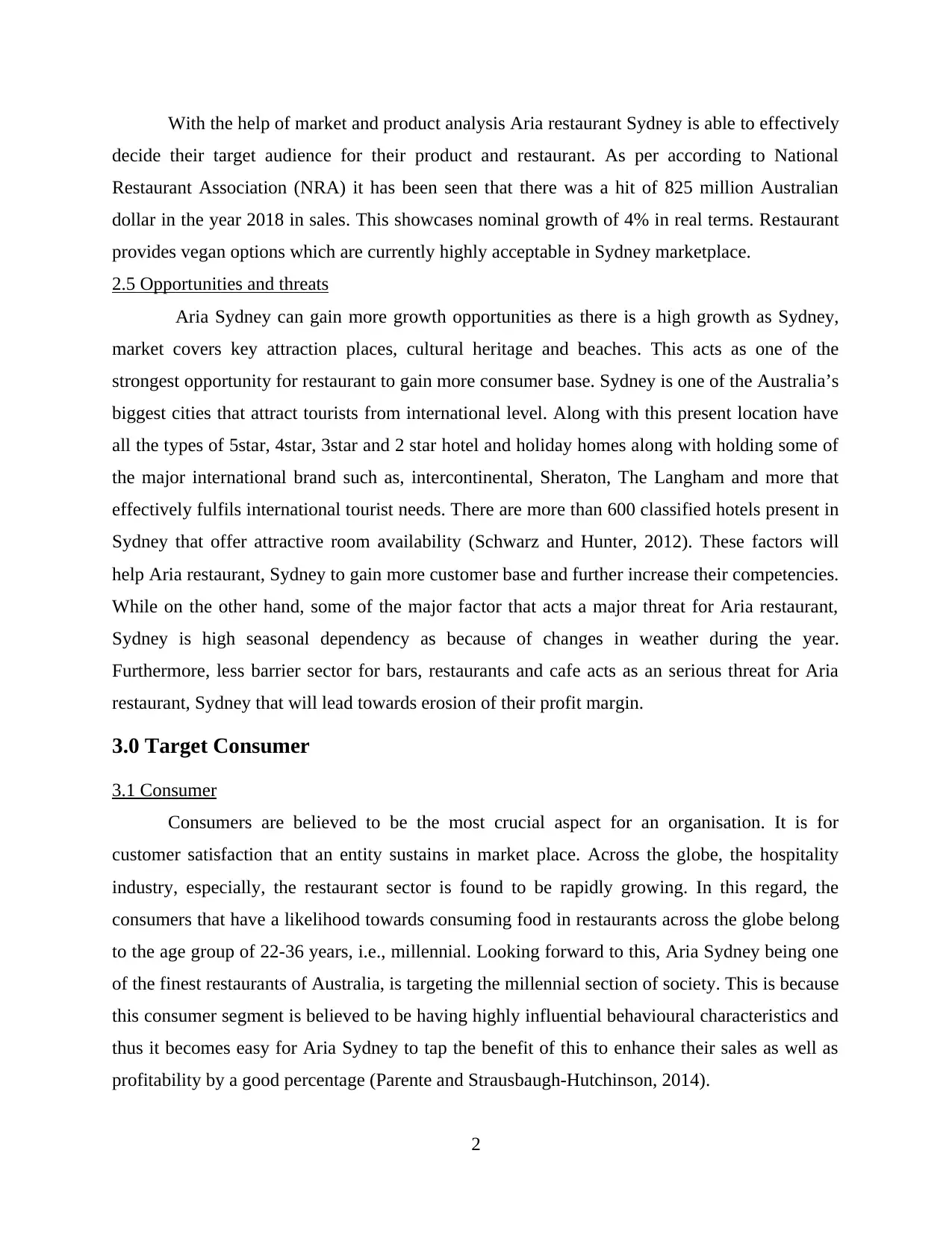
With the help of market and product analysis Aria restaurant Sydney is able to effectively
decide their target audience for their product and restaurant. As per according to National
Restaurant Association (NRA) it has been seen that there was a hit of 825 million Australian
dollar in the year 2018 in sales. This showcases nominal growth of 4% in real terms. Restaurant
provides vegan options which are currently highly acceptable in Sydney marketplace.
2.5 Opportunities and threats
Aria Sydney can gain more growth opportunities as there is a high growth as Sydney,
market covers key attraction places, cultural heritage and beaches. This acts as one of the
strongest opportunity for restaurant to gain more consumer base. Sydney is one of the Australia’s
biggest cities that attract tourists from international level. Along with this present location have
all the types of 5star, 4star, 3star and 2 star hotel and holiday homes along with holding some of
the major international brand such as, intercontinental, Sheraton, The Langham and more that
effectively fulfils international tourist needs. There are more than 600 classified hotels present in
Sydney that offer attractive room availability (Schwarz and Hunter, 2012). These factors will
help Aria restaurant, Sydney to gain more customer base and further increase their competencies.
While on the other hand, some of the major factor that acts a major threat for Aria restaurant,
Sydney is high seasonal dependency as because of changes in weather during the year.
Furthermore, less barrier sector for bars, restaurants and cafe acts as an serious threat for Aria
restaurant, Sydney that will lead towards erosion of their profit margin.
3.0 Target Consumer
3.1 Consumer
Consumers are believed to be the most crucial aspect for an organisation. It is for
customer satisfaction that an entity sustains in market place. Across the globe, the hospitality
industry, especially, the restaurant sector is found to be rapidly growing. In this regard, the
consumers that have a likelihood towards consuming food in restaurants across the globe belong
to the age group of 22-36 years, i.e., millennial. Looking forward to this, Aria Sydney being one
of the finest restaurants of Australia, is targeting the millennial section of society. This is because
this consumer segment is believed to be having highly influential behavioural characteristics and
thus it becomes easy for Aria Sydney to tap the benefit of this to enhance their sales as well as
profitability by a good percentage (Parente and Strausbaugh-Hutchinson, 2014).
2
decide their target audience for their product and restaurant. As per according to National
Restaurant Association (NRA) it has been seen that there was a hit of 825 million Australian
dollar in the year 2018 in sales. This showcases nominal growth of 4% in real terms. Restaurant
provides vegan options which are currently highly acceptable in Sydney marketplace.
2.5 Opportunities and threats
Aria Sydney can gain more growth opportunities as there is a high growth as Sydney,
market covers key attraction places, cultural heritage and beaches. This acts as one of the
strongest opportunity for restaurant to gain more consumer base. Sydney is one of the Australia’s
biggest cities that attract tourists from international level. Along with this present location have
all the types of 5star, 4star, 3star and 2 star hotel and holiday homes along with holding some of
the major international brand such as, intercontinental, Sheraton, The Langham and more that
effectively fulfils international tourist needs. There are more than 600 classified hotels present in
Sydney that offer attractive room availability (Schwarz and Hunter, 2012). These factors will
help Aria restaurant, Sydney to gain more customer base and further increase their competencies.
While on the other hand, some of the major factor that acts a major threat for Aria restaurant,
Sydney is high seasonal dependency as because of changes in weather during the year.
Furthermore, less barrier sector for bars, restaurants and cafe acts as an serious threat for Aria
restaurant, Sydney that will lead towards erosion of their profit margin.
3.0 Target Consumer
3.1 Consumer
Consumers are believed to be the most crucial aspect for an organisation. It is for
customer satisfaction that an entity sustains in market place. Across the globe, the hospitality
industry, especially, the restaurant sector is found to be rapidly growing. In this regard, the
consumers that have a likelihood towards consuming food in restaurants across the globe belong
to the age group of 22-36 years, i.e., millennial. Looking forward to this, Aria Sydney being one
of the finest restaurants of Australia, is targeting the millennial section of society. This is because
this consumer segment is believed to be having highly influential behavioural characteristics and
thus it becomes easy for Aria Sydney to tap the benefit of this to enhance their sales as well as
profitability by a good percentage (Parente and Strausbaugh-Hutchinson, 2014).
2
Paraphrase This Document
Need a fresh take? Get an instant paraphrase of this document with our AI Paraphraser
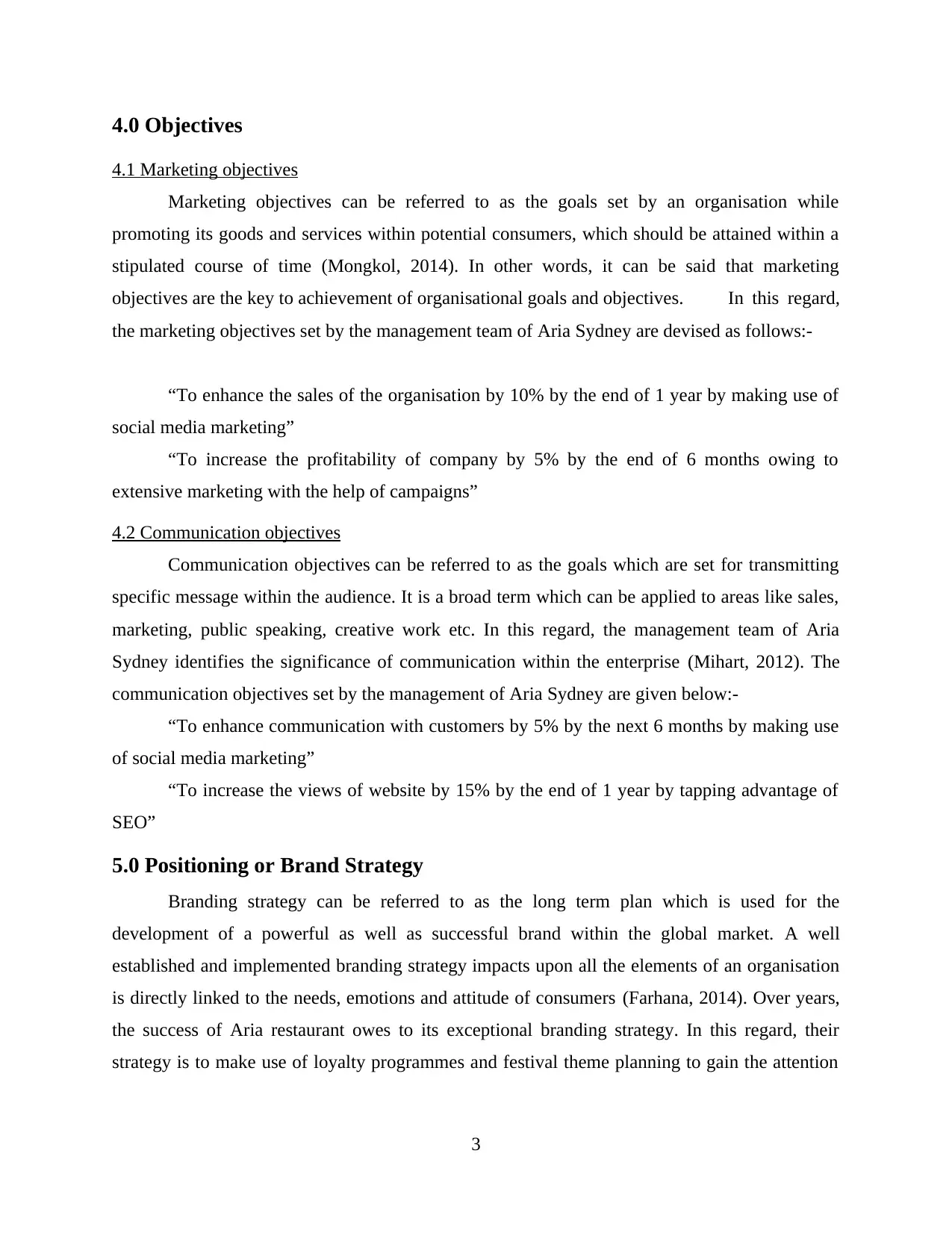
4.0 Objectives
4.1 Marketing objectives
Marketing objectives can be referred to as the goals set by an organisation while
promoting its goods and services within potential consumers, which should be attained within a
stipulated course of time (Mongkol, 2014). In other words, it can be said that marketing
objectives are the key to achievement of organisational goals and objectives. In this regard,
the marketing objectives set by the management team of Aria Sydney are devised as follows:-
“To enhance the sales of the organisation by 10% by the end of 1 year by making use of
social media marketing”
“To increase the profitability of company by 5% by the end of 6 months owing to
extensive marketing with the help of campaigns”
4.2 Communication objectives
Communication objectives can be referred to as the goals which are set for transmitting
specific message within the audience. It is a broad term which can be applied to areas like sales,
marketing, public speaking, creative work etc. In this regard, the management team of Aria
Sydney identifies the significance of communication within the enterprise (Mihart, 2012). The
communication objectives set by the management of Aria Sydney are given below:-
“To enhance communication with customers by 5% by the next 6 months by making use
of social media marketing”
“To increase the views of website by 15% by the end of 1 year by tapping advantage of
SEO”
5.0 Positioning or Brand Strategy
Branding strategy can be referred to as the long term plan which is used for the
development of a powerful as well as successful brand within the global market. A well
established and implemented branding strategy impacts upon all the elements of an organisation
is directly linked to the needs, emotions and attitude of consumers (Farhana, 2014). Over years,
the success of Aria restaurant owes to its exceptional branding strategy. In this regard, their
strategy is to make use of loyalty programmes and festival theme planning to gain the attention
3
4.1 Marketing objectives
Marketing objectives can be referred to as the goals set by an organisation while
promoting its goods and services within potential consumers, which should be attained within a
stipulated course of time (Mongkol, 2014). In other words, it can be said that marketing
objectives are the key to achievement of organisational goals and objectives. In this regard,
the marketing objectives set by the management team of Aria Sydney are devised as follows:-
“To enhance the sales of the organisation by 10% by the end of 1 year by making use of
social media marketing”
“To increase the profitability of company by 5% by the end of 6 months owing to
extensive marketing with the help of campaigns”
4.2 Communication objectives
Communication objectives can be referred to as the goals which are set for transmitting
specific message within the audience. It is a broad term which can be applied to areas like sales,
marketing, public speaking, creative work etc. In this regard, the management team of Aria
Sydney identifies the significance of communication within the enterprise (Mihart, 2012). The
communication objectives set by the management of Aria Sydney are given below:-
“To enhance communication with customers by 5% by the next 6 months by making use
of social media marketing”
“To increase the views of website by 15% by the end of 1 year by tapping advantage of
SEO”
5.0 Positioning or Brand Strategy
Branding strategy can be referred to as the long term plan which is used for the
development of a powerful as well as successful brand within the global market. A well
established and implemented branding strategy impacts upon all the elements of an organisation
is directly linked to the needs, emotions and attitude of consumers (Farhana, 2014). Over years,
the success of Aria restaurant owes to its exceptional branding strategy. In this regard, their
strategy is to make use of loyalty programmes and festival theme planning to gain the attention
3
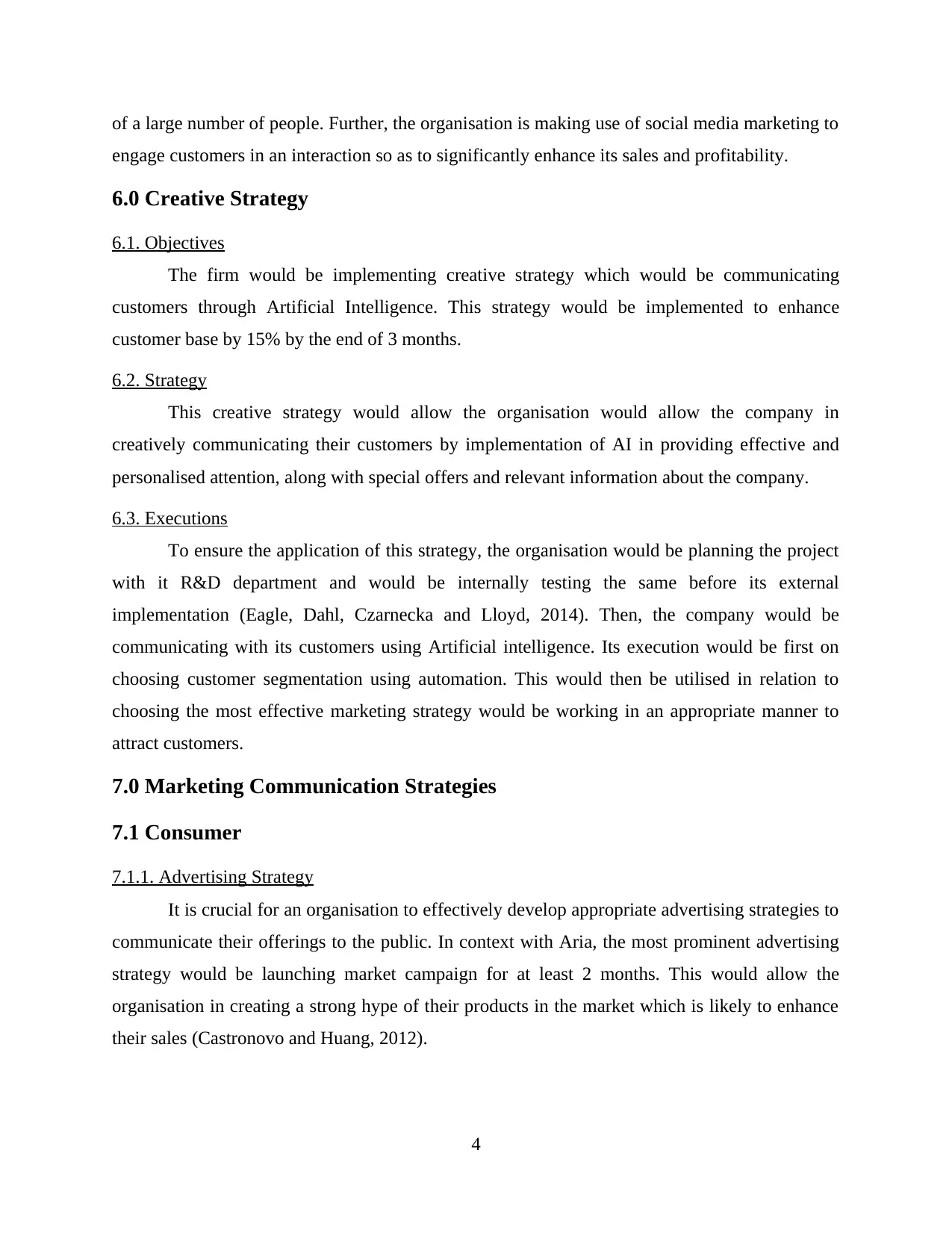
of a large number of people. Further, the organisation is making use of social media marketing to
engage customers in an interaction so as to significantly enhance its sales and profitability.
6.0 Creative Strategy
6.1. Objectives
The firm would be implementing creative strategy which would be communicating
customers through Artificial Intelligence. This strategy would be implemented to enhance
customer base by 15% by the end of 3 months.
6.2. Strategy
This creative strategy would allow the organisation would allow the company in
creatively communicating their customers by implementation of AI in providing effective and
personalised attention, along with special offers and relevant information about the company.
6.3. Executions
To ensure the application of this strategy, the organisation would be planning the project
with it R&D department and would be internally testing the same before its external
implementation (Eagle, Dahl, Czarnecka and Lloyd, 2014). Then, the company would be
communicating with its customers using Artificial intelligence. Its execution would be first on
choosing customer segmentation using automation. This would then be utilised in relation to
choosing the most effective marketing strategy would be working in an appropriate manner to
attract customers.
7.0 Marketing Communication Strategies
7.1 Consumer
7.1.1. Advertising Strategy
It is crucial for an organisation to effectively develop appropriate advertising strategies to
communicate their offerings to the public. In context with Aria, the most prominent advertising
strategy would be launching market campaign for at least 2 months. This would allow the
organisation in creating a strong hype of their products in the market which is likely to enhance
their sales (Castronovo and Huang, 2012).
4
engage customers in an interaction so as to significantly enhance its sales and profitability.
6.0 Creative Strategy
6.1. Objectives
The firm would be implementing creative strategy which would be communicating
customers through Artificial Intelligence. This strategy would be implemented to enhance
customer base by 15% by the end of 3 months.
6.2. Strategy
This creative strategy would allow the organisation would allow the company in
creatively communicating their customers by implementation of AI in providing effective and
personalised attention, along with special offers and relevant information about the company.
6.3. Executions
To ensure the application of this strategy, the organisation would be planning the project
with it R&D department and would be internally testing the same before its external
implementation (Eagle, Dahl, Czarnecka and Lloyd, 2014). Then, the company would be
communicating with its customers using Artificial intelligence. Its execution would be first on
choosing customer segmentation using automation. This would then be utilised in relation to
choosing the most effective marketing strategy would be working in an appropriate manner to
attract customers.
7.0 Marketing Communication Strategies
7.1 Consumer
7.1.1. Advertising Strategy
It is crucial for an organisation to effectively develop appropriate advertising strategies to
communicate their offerings to the public. In context with Aria, the most prominent advertising
strategy would be launching market campaign for at least 2 months. This would allow the
organisation in creating a strong hype of their products in the market which is likely to enhance
their sales (Castronovo and Huang, 2012).
4
⊘ This is a preview!⊘
Do you want full access?
Subscribe today to unlock all pages.

Trusted by 1+ million students worldwide
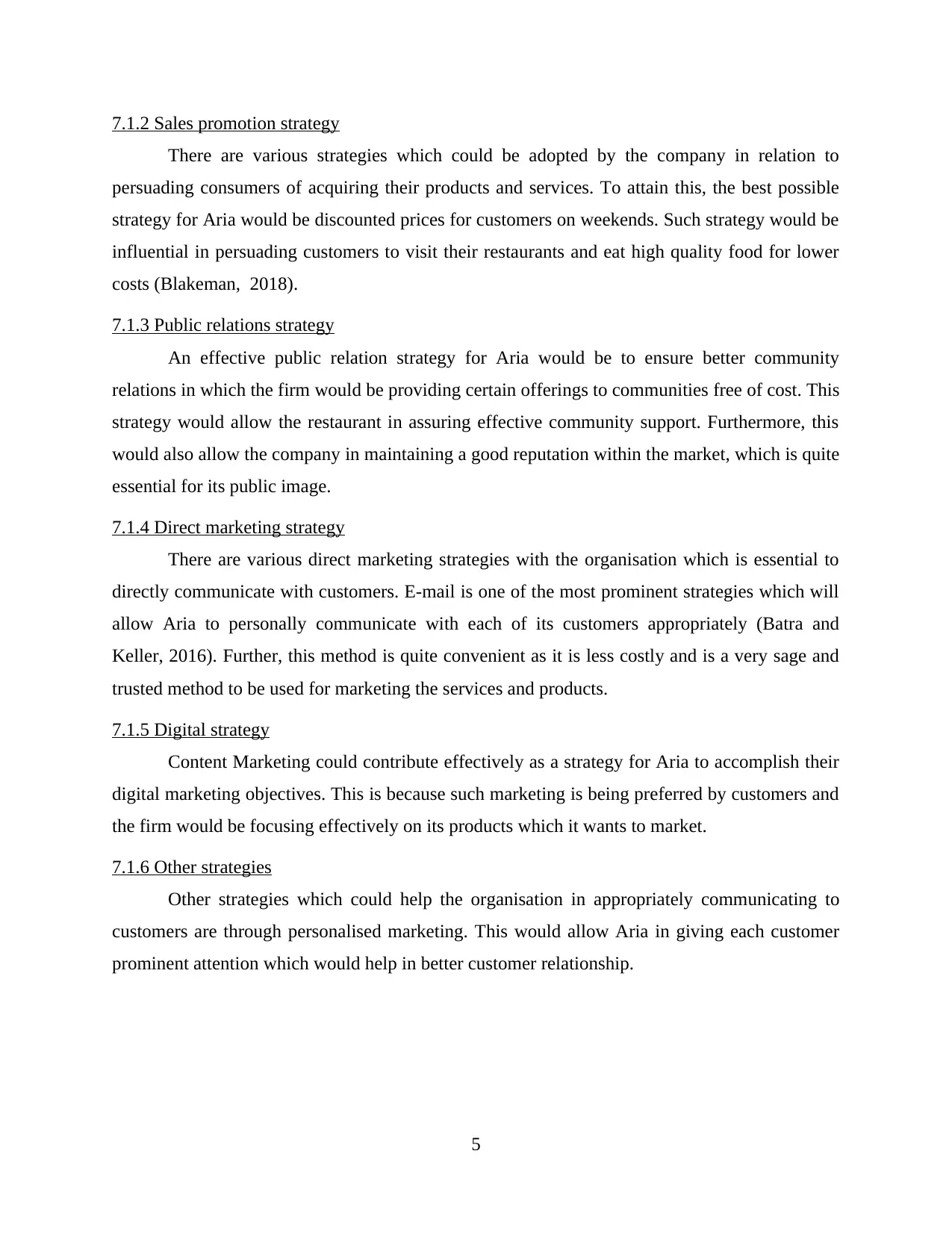
7.1.2 Sales promotion strategy
There are various strategies which could be adopted by the company in relation to
persuading consumers of acquiring their products and services. To attain this, the best possible
strategy for Aria would be discounted prices for customers on weekends. Such strategy would be
influential in persuading customers to visit their restaurants and eat high quality food for lower
costs (Blakeman, 2018).
7.1.3 Public relations strategy
An effective public relation strategy for Aria would be to ensure better community
relations in which the firm would be providing certain offerings to communities free of cost. This
strategy would allow the restaurant in assuring effective community support. Furthermore, this
would also allow the company in maintaining a good reputation within the market, which is quite
essential for its public image.
7.1.4 Direct marketing strategy
There are various direct marketing strategies with the organisation which is essential to
directly communicate with customers. E-mail is one of the most prominent strategies which will
allow Aria to personally communicate with each of its customers appropriately (Batra and
Keller, 2016). Further, this method is quite convenient as it is less costly and is a very sage and
trusted method to be used for marketing the services and products.
7.1.5 Digital strategy
Content Marketing could contribute effectively as a strategy for Aria to accomplish their
digital marketing objectives. This is because such marketing is being preferred by customers and
the firm would be focusing effectively on its products which it wants to market.
7.1.6 Other strategies
Other strategies which could help the organisation in appropriately communicating to
customers are through personalised marketing. This would allow Aria in giving each customer
prominent attention which would help in better customer relationship.
5
There are various strategies which could be adopted by the company in relation to
persuading consumers of acquiring their products and services. To attain this, the best possible
strategy for Aria would be discounted prices for customers on weekends. Such strategy would be
influential in persuading customers to visit their restaurants and eat high quality food for lower
costs (Blakeman, 2018).
7.1.3 Public relations strategy
An effective public relation strategy for Aria would be to ensure better community
relations in which the firm would be providing certain offerings to communities free of cost. This
strategy would allow the restaurant in assuring effective community support. Furthermore, this
would also allow the company in maintaining a good reputation within the market, which is quite
essential for its public image.
7.1.4 Direct marketing strategy
There are various direct marketing strategies with the organisation which is essential to
directly communicate with customers. E-mail is one of the most prominent strategies which will
allow Aria to personally communicate with each of its customers appropriately (Batra and
Keller, 2016). Further, this method is quite convenient as it is less costly and is a very sage and
trusted method to be used for marketing the services and products.
7.1.5 Digital strategy
Content Marketing could contribute effectively as a strategy for Aria to accomplish their
digital marketing objectives. This is because such marketing is being preferred by customers and
the firm would be focusing effectively on its products which it wants to market.
7.1.6 Other strategies
Other strategies which could help the organisation in appropriately communicating to
customers are through personalised marketing. This would allow Aria in giving each customer
prominent attention which would help in better customer relationship.
5
Paraphrase This Document
Need a fresh take? Get an instant paraphrase of this document with our AI Paraphraser
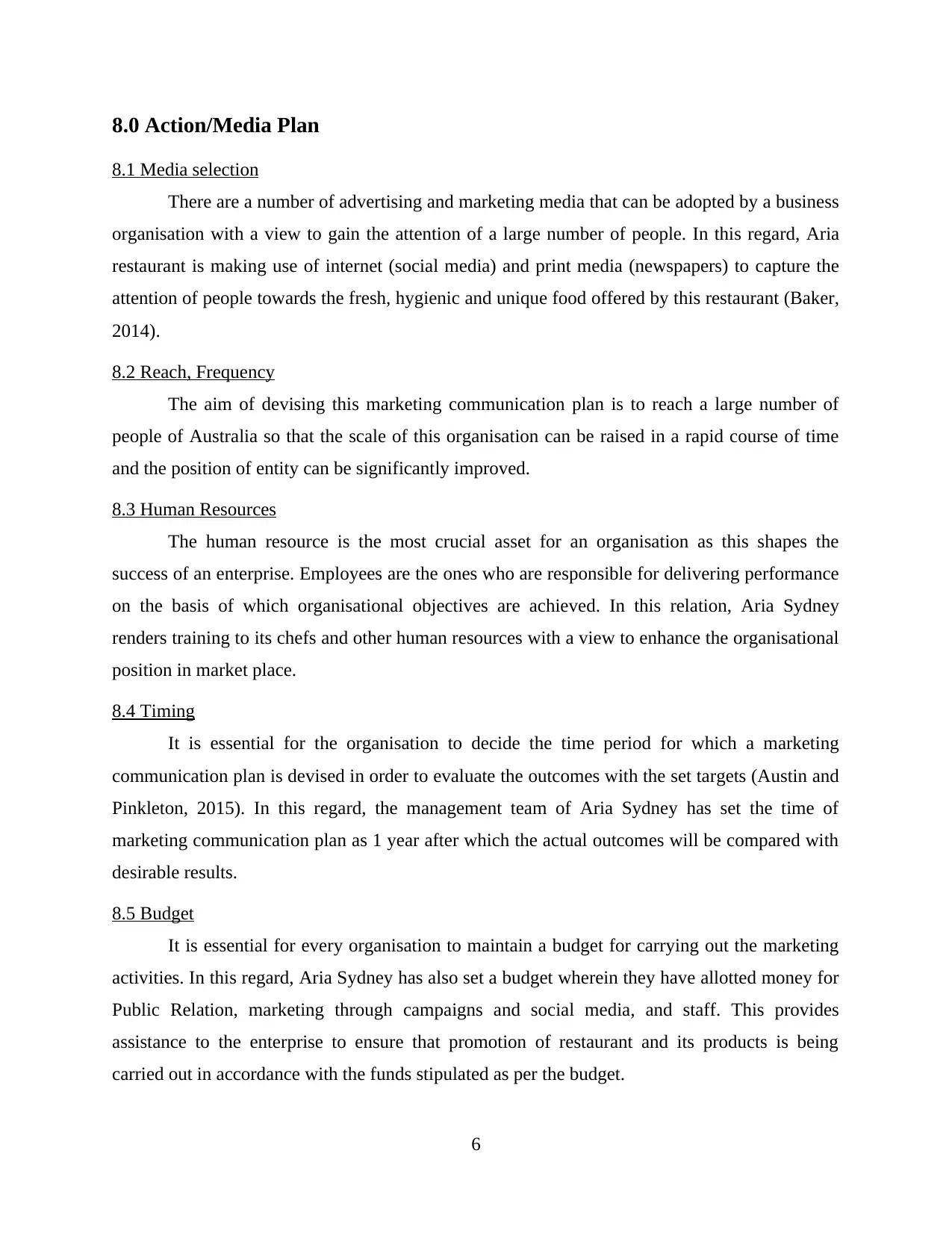
8.0 Action/Media Plan
8.1 Media selection
There are a number of advertising and marketing media that can be adopted by a business
organisation with a view to gain the attention of a large number of people. In this regard, Aria
restaurant is making use of internet (social media) and print media (newspapers) to capture the
attention of people towards the fresh, hygienic and unique food offered by this restaurant (Baker,
2014).
8.2 Reach, Frequency
The aim of devising this marketing communication plan is to reach a large number of
people of Australia so that the scale of this organisation can be raised in a rapid course of time
and the position of entity can be significantly improved.
8.3 Human Resources
The human resource is the most crucial asset for an organisation as this shapes the
success of an enterprise. Employees are the ones who are responsible for delivering performance
on the basis of which organisational objectives are achieved. In this relation, Aria Sydney
renders training to its chefs and other human resources with a view to enhance the organisational
position in market place.
8.4 Timing
It is essential for the organisation to decide the time period for which a marketing
communication plan is devised in order to evaluate the outcomes with the set targets (Austin and
Pinkleton, 2015). In this regard, the management team of Aria Sydney has set the time of
marketing communication plan as 1 year after which the actual outcomes will be compared with
desirable results.
8.5 Budget
It is essential for every organisation to maintain a budget for carrying out the marketing
activities. In this regard, Aria Sydney has also set a budget wherein they have allotted money for
Public Relation, marketing through campaigns and social media, and staff. This provides
assistance to the enterprise to ensure that promotion of restaurant and its products is being
carried out in accordance with the funds stipulated as per the budget.
6
8.1 Media selection
There are a number of advertising and marketing media that can be adopted by a business
organisation with a view to gain the attention of a large number of people. In this regard, Aria
restaurant is making use of internet (social media) and print media (newspapers) to capture the
attention of people towards the fresh, hygienic and unique food offered by this restaurant (Baker,
2014).
8.2 Reach, Frequency
The aim of devising this marketing communication plan is to reach a large number of
people of Australia so that the scale of this organisation can be raised in a rapid course of time
and the position of entity can be significantly improved.
8.3 Human Resources
The human resource is the most crucial asset for an organisation as this shapes the
success of an enterprise. Employees are the ones who are responsible for delivering performance
on the basis of which organisational objectives are achieved. In this relation, Aria Sydney
renders training to its chefs and other human resources with a view to enhance the organisational
position in market place.
8.4 Timing
It is essential for the organisation to decide the time period for which a marketing
communication plan is devised in order to evaluate the outcomes with the set targets (Austin and
Pinkleton, 2015). In this regard, the management team of Aria Sydney has set the time of
marketing communication plan as 1 year after which the actual outcomes will be compared with
desirable results.
8.5 Budget
It is essential for every organisation to maintain a budget for carrying out the marketing
activities. In this regard, Aria Sydney has also set a budget wherein they have allotted money for
Public Relation, marketing through campaigns and social media, and staff. This provides
assistance to the enterprise to ensure that promotion of restaurant and its products is being
carried out in accordance with the funds stipulated as per the budget.
6
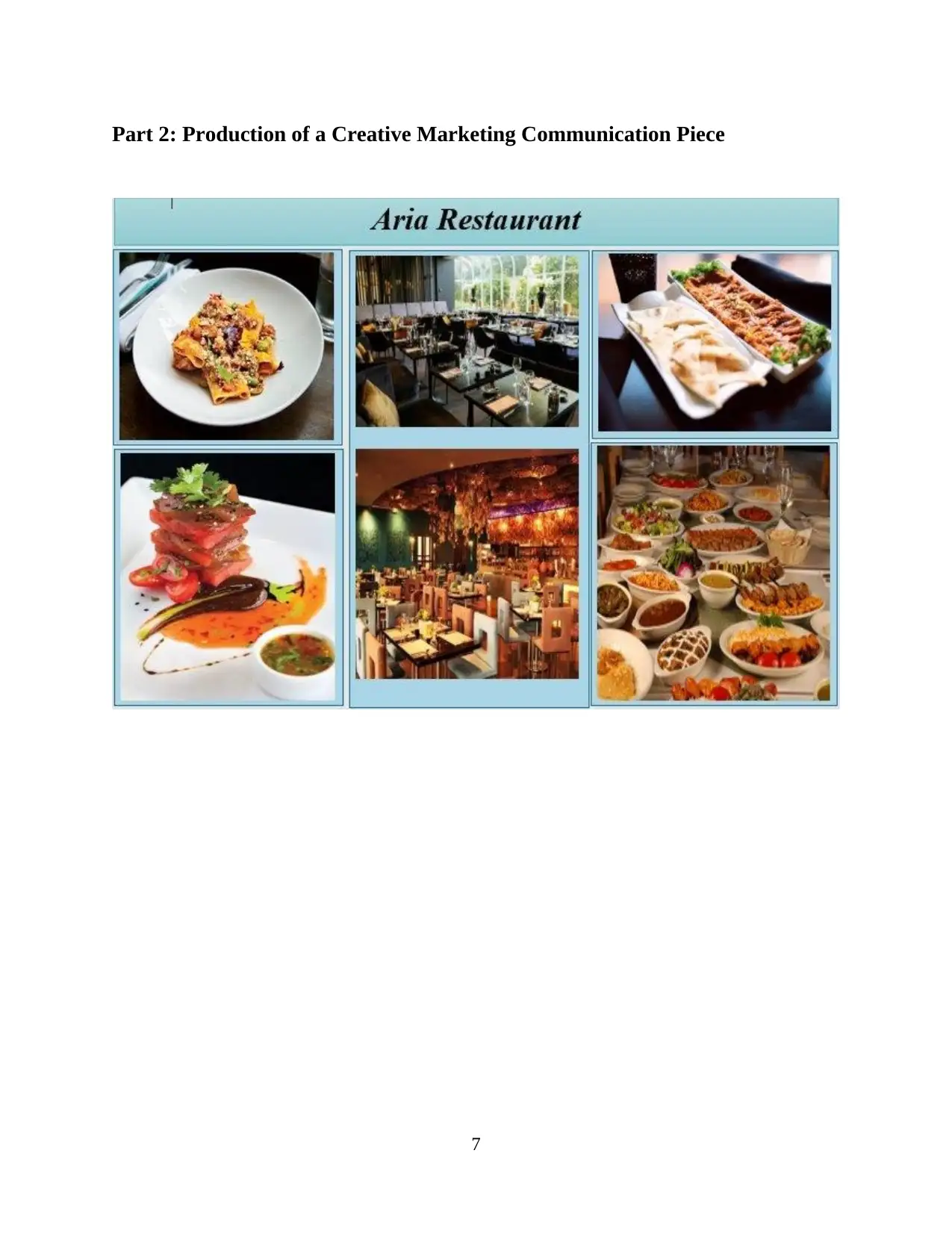
Part 2: Production of a Creative Marketing Communication Piece
7
7
⊘ This is a preview!⊘
Do you want full access?
Subscribe today to unlock all pages.

Trusted by 1+ million students worldwide
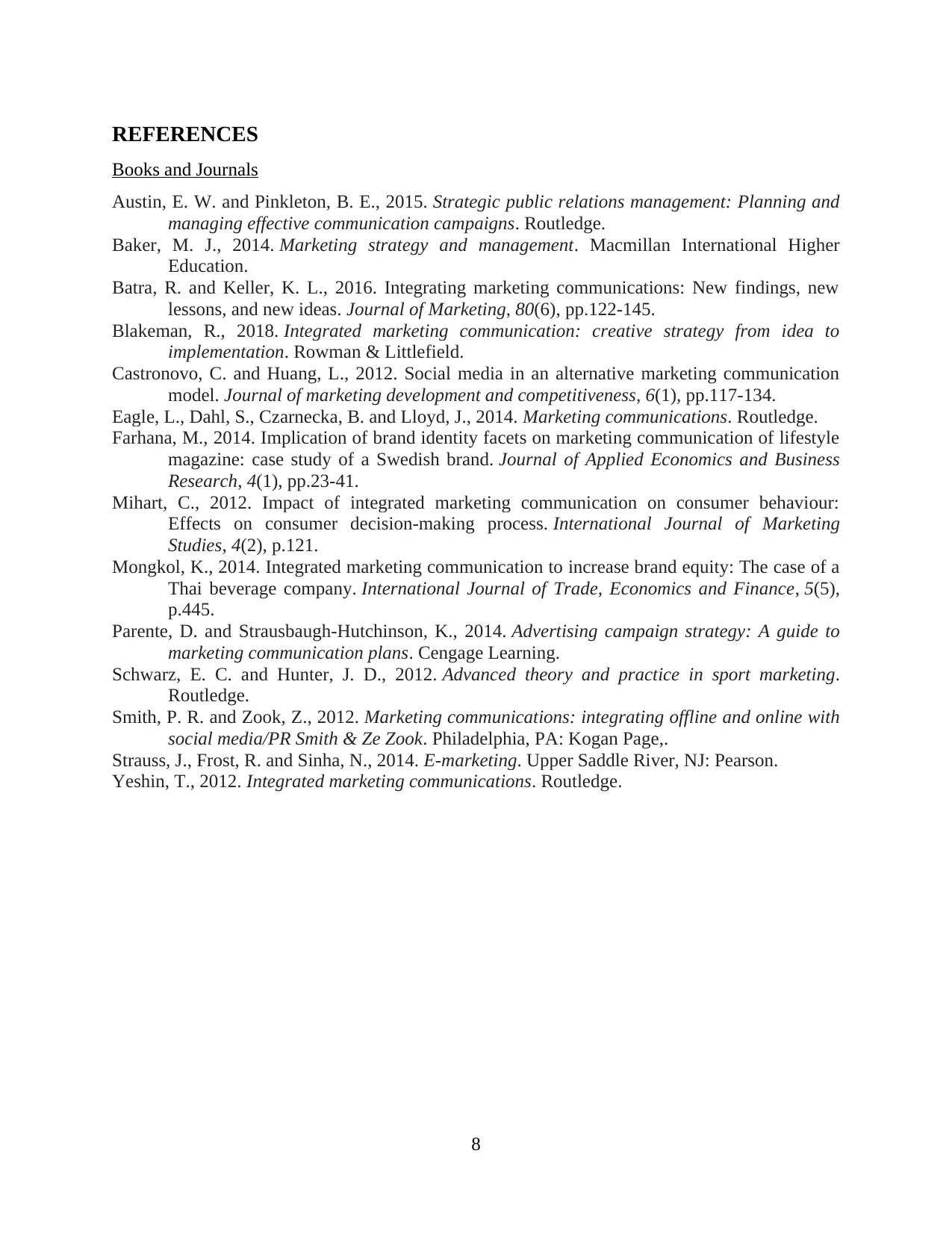
REFERENCES
Books and Journals
Austin, E. W. and Pinkleton, B. E., 2015. Strategic public relations management: Planning and
managing effective communication campaigns. Routledge.
Baker, M. J., 2014. Marketing strategy and management. Macmillan International Higher
Education.
Batra, R. and Keller, K. L., 2016. Integrating marketing communications: New findings, new
lessons, and new ideas. Journal of Marketing, 80(6), pp.122-145.
Blakeman, R., 2018. Integrated marketing communication: creative strategy from idea to
implementation. Rowman & Littlefield.
Castronovo, C. and Huang, L., 2012. Social media in an alternative marketing communication
model. Journal of marketing development and competitiveness, 6(1), pp.117-134.
Eagle, L., Dahl, S., Czarnecka, B. and Lloyd, J., 2014. Marketing communications. Routledge.
Farhana, M., 2014. Implication of brand identity facets on marketing communication of lifestyle
magazine: case study of a Swedish brand. Journal of Applied Economics and Business
Research, 4(1), pp.23-41.
Mihart, C., 2012. Impact of integrated marketing communication on consumer behaviour:
Effects on consumer decision-making process. International Journal of Marketing
Studies, 4(2), p.121.
Mongkol, K., 2014. Integrated marketing communication to increase brand equity: The case of a
Thai beverage company. International Journal of Trade, Economics and Finance, 5(5),
p.445.
Parente, D. and Strausbaugh-Hutchinson, K., 2014. Advertising campaign strategy: A guide to
marketing communication plans. Cengage Learning.
Schwarz, E. C. and Hunter, J. D., 2012. Advanced theory and practice in sport marketing.
Routledge.
Smith, P. R. and Zook, Z., 2012. Marketing communications: integrating offline and online with
social media/PR Smith & Ze Zook. Philadelphia, PA: Kogan Page,.
Strauss, J., Frost, R. and Sinha, N., 2014. E-marketing. Upper Saddle River, NJ: Pearson.
Yeshin, T., 2012. Integrated marketing communications. Routledge.
8
Books and Journals
Austin, E. W. and Pinkleton, B. E., 2015. Strategic public relations management: Planning and
managing effective communication campaigns. Routledge.
Baker, M. J., 2014. Marketing strategy and management. Macmillan International Higher
Education.
Batra, R. and Keller, K. L., 2016. Integrating marketing communications: New findings, new
lessons, and new ideas. Journal of Marketing, 80(6), pp.122-145.
Blakeman, R., 2018. Integrated marketing communication: creative strategy from idea to
implementation. Rowman & Littlefield.
Castronovo, C. and Huang, L., 2012. Social media in an alternative marketing communication
model. Journal of marketing development and competitiveness, 6(1), pp.117-134.
Eagle, L., Dahl, S., Czarnecka, B. and Lloyd, J., 2014. Marketing communications. Routledge.
Farhana, M., 2014. Implication of brand identity facets on marketing communication of lifestyle
magazine: case study of a Swedish brand. Journal of Applied Economics and Business
Research, 4(1), pp.23-41.
Mihart, C., 2012. Impact of integrated marketing communication on consumer behaviour:
Effects on consumer decision-making process. International Journal of Marketing
Studies, 4(2), p.121.
Mongkol, K., 2014. Integrated marketing communication to increase brand equity: The case of a
Thai beverage company. International Journal of Trade, Economics and Finance, 5(5),
p.445.
Parente, D. and Strausbaugh-Hutchinson, K., 2014. Advertising campaign strategy: A guide to
marketing communication plans. Cengage Learning.
Schwarz, E. C. and Hunter, J. D., 2012. Advanced theory and practice in sport marketing.
Routledge.
Smith, P. R. and Zook, Z., 2012. Marketing communications: integrating offline and online with
social media/PR Smith & Ze Zook. Philadelphia, PA: Kogan Page,.
Strauss, J., Frost, R. and Sinha, N., 2014. E-marketing. Upper Saddle River, NJ: Pearson.
Yeshin, T., 2012. Integrated marketing communications. Routledge.
8
1 out of 10
Related Documents
Your All-in-One AI-Powered Toolkit for Academic Success.
+13062052269
info@desklib.com
Available 24*7 on WhatsApp / Email
![[object Object]](/_next/static/media/star-bottom.7253800d.svg)
Unlock your academic potential
Copyright © 2020–2025 A2Z Services. All Rights Reserved. Developed and managed by ZUCOL.





